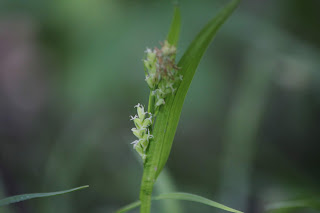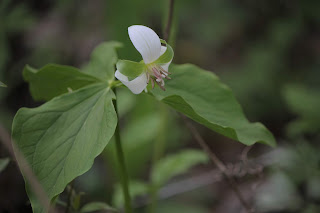This past Saturday, I did my annual trip down to Point Pelee, the southernmost tip in mainland Canada. Pelee is a well-known haunt for many birders in May, and low and behold, I am one of those birders.
The day started early. I arrived in the park about 5:15, and was at the VC and began the walk to the Tip at around 5:30. I planned to walk the road in hopes of finding a nightjar, in particular, Chuck-wills-widow. Thoughts of this species had been circling in my mind in the days leading up to the trip, and the day before I was to go, one had been found on the road. Perhaps my fantasy was to come true!
Alas, no nightjars were found on the road, but at least I was the second one at the Tip! I even got to see the Tip Tower for the first time. It is a sight to behold...but it wasn't open. Apparently it didn't pass its safety inspection. I'm sure there is a whole story behind that!
Upon arrival at the Tip, I was greeted by a number of Black-bellied Plovers, Ruddy Turnstones, a Sanderling, and a nice Red Knot.
 |
| Black-bellied Plovers |
 |
| Nice bird, knot a nice photo |
Soon, birds started "reverse migrating", in which birds will fly off the Tip towards the lake, and then they may circle back around to the mainland. It wasn't super intense, however there were a couple highlights, such as a Brown Thrasher flying in off the lake, and some Tennessee Warblers flying around people's feet. This is when my camera started acting up, so photos are limited.
 |
| Baltimore Oriole |
After birding the Tip a bit, we walked up the West Beach trail. We flushed a Sora of all things while walking through a wooded part of the footpath, which was quite odd! A few non-birds too...
 |
| Ebony Sedge (Carex ebenea) |
 |
| Eastern Prickly Pear Cactus (Opuntia cespitosa) |
 |
| Orchard Oriole |
Next was Tilden's Woods trail. A few warblers here and there, most notably Canada Warbler and a few Northern Waterthrushes.
 |
| Canada Warbler |
 |
| Northern Waterthrush |
American Jumpseed (
Persicaria virginiana) was found here and there throughout.
We went next to Cactus Field, but no luck there. Though I must say, Common Yellowthroats can do a mean Sedge Wren impression! We did a tad more birding north of Cactus Field, but didn't get too far as an alert came through for a Worm-eating Warbler (pretty rare in Ontario) on Redbud trail!
We bee-lined it for the trail, but had to make a quick stop for a Blackburnian Warbler on the lawn near the VC parking lot. It came quite close, and even
perched on my foot at one point!
We rode the tram to the halfway stop, then got off and began the search for the Worm-eating Warbler. Nobody had seen it in about 30 minutes, but we were determined. Lucky us happened to be standing in the right place at the right time, and it flew in right in front of us! It was quite elusive, but I managed a couple of usable pictures before I got out of the way so others could see the bird (I am a bit on the tall side).
The Worm-eating was actually a lifer for me, so I was quite happy. It was probably the bird that I wanted to see the most this spring, especially after missing a couple prior here and there.
After success with the Worm, we headed to take a peek for Prothonotary Warblers. We were successful right away. I actually missed Prothons at Pelee last year, and the only one I saw all year was in London (so I guess I can't complain).
There were a couple plants of interest.
 |
| Large-flowered Bellwort (Uvularia grandiflora) |
 |
| Canada Mayflower (Maianthemum canadense) |
Walking back down Redbud, I was tapped on the shoulder, and told about another rare bird...a roosting Chuck-wills-widow!
I joined the convey of birders as we made our way through Post Woods to where the Chuck was roosting. Took me a bit to actually spot it, but once I did...woohoo! Another lifer, and the bird I had hoped for going into the day.
A Blue-headed Vireo stopped by for a visit.
After the Chuck, I walked around a bit more, before catching the tram back to the VC, where I hopped off and went and saw the reported Cerulean Warbler. It was right on the ground at our feet!
After the Cerulean, we went to the Marsh Boardwalk. A few non-birds were seen.
 |
| Midland Painted Turtle |
 |
| Golden Shiners |
Next, we wanted to go to Hillman, but first we checked out Orientation on our way out of the park. Bay-breasted Warbler was my 100th species of the day.
Hillman was pretty quiet. A few more ducks, and some shorebirds.
 |
| Short-billed Dowitchers |
We went back to the park, as we had word on two more roosting nightjar species in the park, and we wanted to go for the nightjar trifecta. in addition to the Chuck, our second nightjar of the day was Common Nighthawk at Sleepy Hollow.
The third species of the day was Eastern Whip-poor-will, which was sitting on a log not too far from the side of the road! Hands down my best look at the species.
We heard rumours of a Golden-winged Warbler on Redbud. We had been trying to find a Golden-winged all day, and had even followed up on a couple of reports. It was a bit of deja vu for us, as last year, we did the same thing with Mourning Warbler. To add to it, the Golden-winged Warbler was under the same exact same log as the Mourning Warbler, which we had finally managed to catch up with late in the day!
After receiving word of a Kentucky Warbler in Post Woods, we decided to go and try to find it. We searched in the area where it had been seen, but with no luck. At this point my friends I had been birding with all day decided to call it a day. After saying goodbye, I continued up the path. After another 100 meters up the trail, I came across a small group of birders looking at the underbrush. I pointed my binoculars in the direction they were pointing, and low and behold, it was the Kentucky Warbler! No photos, as I only got a couple glimpses before it disappeared.
Since I was walking by the Chuck again, I grabbed a few more photos. Three nightjars on one eBird checklist, not what I was expecting to do on this day!
I made one last trip to the Tip. A couple bluebirds were on the east side.
The Tip is the longest I have seen it in years. As such, four species of gulls were seen.
 |
| Ring-billed Gull |
 |
| Great Black-backed Gull |
 |
| Herring Gull |
 |
| Bonaparte's Gull |
A few warblers were on the rocks along the west side of the Tip.
 |
| Yellow-rumped Warbler |
 |
| Chestnut-sided Warbler |
After missing it all day, I finally saw the Least Bittern that had been hanging out all day at the Tip, thanks to my mom pointing it out. It didn't look too good.
One last loop of Woodland Nature Trail resulted in a couple new birds for the day, such as Hermit Thrush, Blue-winged Warbler, and Great Egret. By this time it was getting dark, and such pretty much marked the end of my day. Appendage Waterleaf (
Hydrophyllum appendiculatum) is an endangered species in Ontario, but it was seen along the paths.
It was a great day, with something like 125 or so species seen. Not too bad given the day and the amount of effort I put in. And heck, two lifers in one day is pretty great too!
Looking forward to see what the remainder of spring brings!








































































